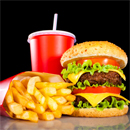Trans Fat: Friend Or Foe?
The United States Food and Drug Administration (FDA) recently issued new Dietary Guidelines for Americans. While we’re thankful that the government is working to keep us safe, we’re a little disappointed that the new dietary rules don’t go far enough in advising people to stay away from one particularly dangerous type of fat: trans fat.
The government’s new nutritional guidelines note that you should limit trans fats as much as possible, but many nutrition experts think that message should have been much stronger: rather than suggest that people limit trans fats, the guidelines should have told people to avoid them as much as possible.
Dr. Howard LeWine, chief editor for internet publishing at Harvard Health Publications, sums it up: “Trans fats have no nutritional value whatsoever, so eating them doesn’t add anything beneficial to your diet.” Trans fats do, however, have troublesome health effects. They raise LDL (“bad”) cholesterol and lower HDL (“good”) cholesterol – the worst possible combination.
Meat and dairy foods naturally contain small amounts of trans fats. But the biggest sources of trans fats for most Americans are packaged goods like crackers and cookies, fried fast food, and many margarines. Here’s how you can avoid trans fats:
+ Use canola and olive oils for cooking and salads. If you choose margarine, always go with the soft ones. Generally, the softer a margarine is at room temperature, the lower in trans fat.
+ Read the ingredients on food labels before you buy. If it says “shortening,” “partially hydrogenated oil,” or “hydrogenated oil,” put it back on the shelf. These indicate the presence of trans fats.
+ Do some math. If the grams of polyunsaturated fat, saturated fat, and monounsaturated fat are listed on a label, add them together and subtract the sum from “Total Fat.” What’s left is trans fat.
+ Stay away from fried foods in restaurants.
The rest of the new guidelines are a step in the right direction. The old guidelines focused on avoiding all fats and eating more carbohydrates. The new guidelines rightly put the primary emphasis on taking in fewer calories from all sources. When choosing carbohydrates, they note that it’s best to pick fiber-rich fruits and vegetables and whole grains.
++++++++++++++++++++++++++++++
For more information on TRANS FATS, keep reading…..
++++++++++++++++++++++++++++++
“How do animal products contain small amounts of trans fats if this form of fat is created by a laboratory process?” It’s true that trans fats became a big part of the American diet when scientists discovered that heating vegetable oil and bubbling hydrogen through it produced a new type of fat that stayed solid at room temperature and had a longer shelf life. The process, called hydrogenation, converts healthy vegetable oils into the unhealthy trans fats that can raise “bad” LDL cholesterol and lower “good” HDL cholesterol. This new fat was a boon to packaged baked goods, for example: the cookies and crackers that are loaded with trans fats.
Clearly animal products like beef and milk aren’t made in a lab, so how could they contain trans fats? In this case, the animal’s stomach acts as the lab – the digestive process produces hydrogen, which mixes with the unsaturated fatty acids from the cow’s diet and small amounts of trans fat are born. But because trans fats are found in much greater amounts in foods like donuts, cookies, crackers, and other sweets, avoiding these foods is a much more effective way to cut down on trans fats than cutting low-fat dairy products from your diet.
According to the FDA rule, a food may be labeled as trans fat free “…only when there is less than 0.5 grams of trans fat and less than 0.5 grams of saturated fat per reference amount and per labeled serving.”
Sources:
Harvard Health Publications; Harvard Medical School
www.fda.gov
++++++++++++++++++++++++++++++
Other Sources For Additional Research:
For more information on ways to improve your eating habits, order the special health report “Healthy Eating: A Guide to the New Nutrition” at www.health.harvard.edu/HE
FDA Questions & Answers on Trans Fat:
http://www.cfsan.fda.gov/~dms/qatrans.html
FDA Nutrition Labeling Requirements for Trans Fat:
http://www.cfsan.fda.gov/~lrd/hhtfacid.html#fact
FDA Main Website: http://www.fda.gov/
FDA “Lose Weight” Website: http://www.fda.gov/loseweight/
* Copyright 2005 Pick Up The Pace. Permission is not required for the distribution of Pick Up The Pace articles as long as they are used in their entirety, are properly credited to Pick Up The Pace, and are accompanied by our website link: www.letspickupthepace.com.
* The information in this article and on this site is for general reference purposes only and not intended to address specific medical conditions. This information is not a substitute for professional medical advice or a medical exam. Prior to participating in any exercise program or activity, you should seek the advice of your physician or other qualified health professional. No information in this article or on www.letspickupthepace.com should be used to diagnose, treat, cure or prevent any medical condition.

Tracie Johanson is the founder of Pick Up The Pace, a 30-minute exercise studio for women, focusing on fitness, health and nutrition for maximum weight loss. Please visit http://www.letspickupthepace.com for more information.
- Prev:We Can Do It!
- Next:Timing Is Everything – Part 3
-
Don’t Let Me Down by The Chainsmokers Ft. Daya Interpretation
-
Unsurpassed exercises to combatTummy fat
-
Amazing Benefits of Body Building Supplements
-
When You Need Morbid Obesity Surgery
If you are morbidly obese and you have problems with weight loss, you
-
The key to fatloss
-
Weight Loss: Perception and Reality
- DON'T MISS
- Selecting the Right Diet Pills for Weight Loss
- If No One Sees You Eat It, It Has No Calories!
- Fast Weight Loss
- Doing This is Just as Dangerous as Smoking
- Weight Loss Information — Setting Effective Goals
- The Best Weight Loss Program
- The Best Way To Lose Weight Forever
- Determining the Efficacy of Diet Pills
- 7 Useful Tips That Will Help You Lose Weight
- Diet Pills-The Ultimate Solution for Weight Loss




